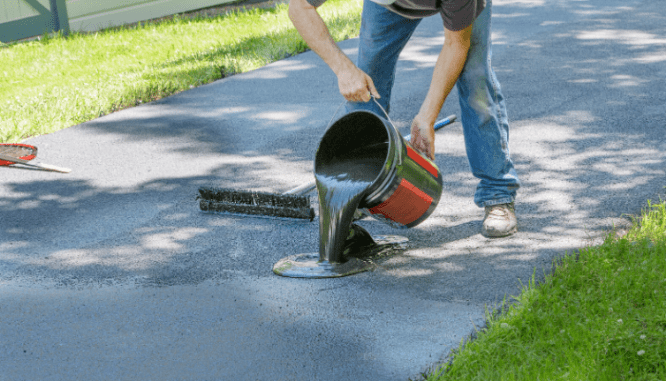Selling a House with a Shared Driveway: How to Clear the Roadblocks Ahead
- Published on
- 4 min read
-
 Valerie Kalfrin Contributing AuthorClose
Valerie Kalfrin Contributing AuthorClose Valerie Kalfrin Contributing Author
Valerie Kalfrin Contributing AuthorValerie Kalfrin is a multiple award-winning journalist, film and fiction fan, and creative storyteller with a knack for detailed, engaging stories.
We all learned how to share as children, but that concept tends to work easier with crayons and cookies rather than property.
Take a shared driveway, for instance. This type of setup, where two or more people jointly own a driveway but negotiate maintenance and use, can crop up in cities and suburbs alike. When the parties are agreeable, a shared driveway is just another quirk of your home. No one hogs the other’s half or blocks the neighbor’s access with bad parking. Everyone’s a happy camper.
Unfortunately, that civility depends on how well you get along with your neighbors. Some residents have sued each other over how to navigate a shared driveway. Others might have a pleasant arrangement until one of them moves, leaving the remaining homeowner to assert that the shared driveway is theirs alone because they’ve used it longer, regardless of what a property survey says.
“The next buyer quite possibly walks into a quagmire,” said Bryan Kasprisin, a top real estate agent in Joliet, Illinois, who has sold several properties with shared driveways. So how can a seller assure smooth sailing?

Talk about the positives
A shared driveway can be a single space as wide as a single-car driveway (roughly 9 to 12 feet, although some can be smaller) or a double-car driveway (roughly 20 to 24 feet). They also can take the shape of a “Y,” a fish bone, or a flag on a pole. The plusses of such an arrangement might not immediately leap to mind, but there are advantages to a shared driveway:
Shared maintenance:
As long as a proper deed specifies equal ownership, all owners can shoulder the costs and labor of shoveling show, removing motor oil stains, or resealing the concrete or asphalt because of cracks.
Coveted parking:
In metropolitan areas like Brooklyn, New York, where parking is at a premium, a shared driveway is a “coveted” feature, regardless of having to split it with someone else.
Clearer, safer streets:
Streets with housing close together can appear clearer and become safer by reducing “vehicular access points,” such as driveways, said one steering committee about proposed road improvements in Washtenaw County, Michigan. “Sharing or joint use of a driveway by two or more property owners should be encouraged,” the committee’s report said.
Address typical buyer concerns over shared driveways
Some people refer to a shared driveway as a “common driveway,” but it has a legal definition. Almost all shared driveways are “appurtenant easements,” or rights to “exercise a limited form of ownership or possession of the property of another individual,” real estate lawyers say. These rights attach to the ownership of the land and typically pass along to the new owner.
An easement can specify that each homeowner owns part of the driveway but has the legal right to use the full space to drive to and from the garage, according to Nolo.com, a leading legal website since 2011. Other times, one homeowner owns the entire driveway, and the easement grants the neighbor sharing the driveway the right to use part of it, such as parking to one side or for reaching the garage.
Concerns that often arise with shared driveways include:
- One neighbor blocks how the other can reach the garage, the front door, or his or her car.
- Children leave bicycles or toys in the driveway.
- One neighbor fails to shovel snow or share in the cost of repairs.
- Neighbors mark out their driveway space with paint, posts, or other dividers.
- There’s uncertainty over legal liability regarding anyone injured in the driveway.

Disclose the property rights
Kasprisin said he always discloses when a property has a shared driveway and often must explain to buyers what this means. “Sometimes it’s not an issue to the buyer until we make it an issue by letting them know this is what might happen,” he said. “It doesn’t really bother a buyer until they find out what the liability is or what the problems that could arise are.”
Easements are recorded within the county where a property is located, so a title report or a property survey should outline a prospective buyer’s ownership rights. Einhorn, Barbarito, Frost & Botwinick, a Denville, New Jersey, law firm that handles real estate cases, says that homeowners also can check their title insurance policy about any easements regarding the use of or access to the driveway.
However, there are neighbors who try to exercise more rights than they should upon learning they’ll have someone new next door. Kasprisin encountered this situation selling an 1895 Victorian home in Joliet, Illinois. The neighbor took the position that he owned the driveway because he’d lived on the street longer and told the buyer, “Just make sure that your people don’t park in the driveway,” the agent said.
It turns out that the property line ran through the center of the driveway, giving the buyer the legal right to use half of it, just like the seller had. With the help of a real estate attorney, both parties drafted a maintenance agreement that outlined maintenance, liability, and access. (As of January 2020, 21 states require that a real estate attorney be present at closing, whereas other states require an attorney only to prepare certain documents.)
“Some of it was just basic courtesy that I believe should go unsaid, [such as] promise not to park in the middle and not leave your car there on a Saturday night,” Kasprisin said.
Negotiate the rights or divide it if needed
Marshall, Roth & Gregory, a law firm in Asheville, North Carolina, that handles estate planning and real estate transactions, said that real estate agents should be alert for any such “shared access issues” before listing the property, as well as before closing. Regardless of how the shared driveway has been used previously, the owners and users should record their property boundaries, responsibilities, and costs in a document such as a Shared Driveway Agreement, these lawyers say.
Some lenders will not grant loan approval to prospective buyers interested in a property with a shared driveway without such a recorded legal document, they added.
A Shared Driveway Maintenance Agreement can be as brief as a few paragraphs or meticulously detailed over several pages. It should include:
- a legal description of the driveway (hire a land surveyor to measure the plot, record data, and research land records)
- how the parties share the driveway (type of easement, for instance)
- specifics about sharing costs of maintenance, removing snow and ice, and other improvements
- stipulations for nonpayment, such as that one party has the right to place a lien against the other.
However, if you’ve had a particularly tense relationship with your neighbors about shared use of the driveway, you may find that dividing the driveway is the better option before selling.
The divider must be on your side of the property and provide adequate width for both users, which a professional surveyor can measure. (You may want to speak to your neighbor beforehand about your plans so they can hire a surveyor as well.) Some dividers include chain-link fencing installed into asphalt, edging stones set atop existing concrete, or a narrow raised garden bed of pressure-treated lumber.

How a shared driveway impacts your pricing strategy
When selling a home with a shared driveway, your real estate agent will use comparable properties to help set the asking price. But depending on how common shared driveways are in your area, your agent may not have to adjust the price to compensate.
“You have to look at it case by case, house by house,” Kasprisin said. If your shared driveway is the only one in a residential neighborhood where everyone else has their own driveway, “it’s going to affect value a little bit because it’s something different.”
However, if a shared driveway is the norm in your neighborhood, there’s no need of an adjustment, as with the Victorian home that Kasprisin sold. “I didn’t factor the driveway at all into the pricing strategy,” he said. “If you want to live in that neighborhood or in that type of house, that just goes part and parcel with being there.”
A buyer also may find that a shared driveway isn’t much of a trade-off for some other benefit, he added. “If I’ve got a seven-car garage but I’ve got a shared driveway, I might not want the shared driveway, but wow, I can get a seven-car garage. Sometimes you take the good with the bad.”
A shared driveway might be usual to some buyers, but it doesn’t have to become a barrier to selling your house. “It’s just [a matter of] clear and distinct expectations: ‘This is what needs to be done,’” Kasprisin said. “Like everything else, if everybody has that, then they should be OK.”
Header Image Source: (ThomBal / Shutterstock)
